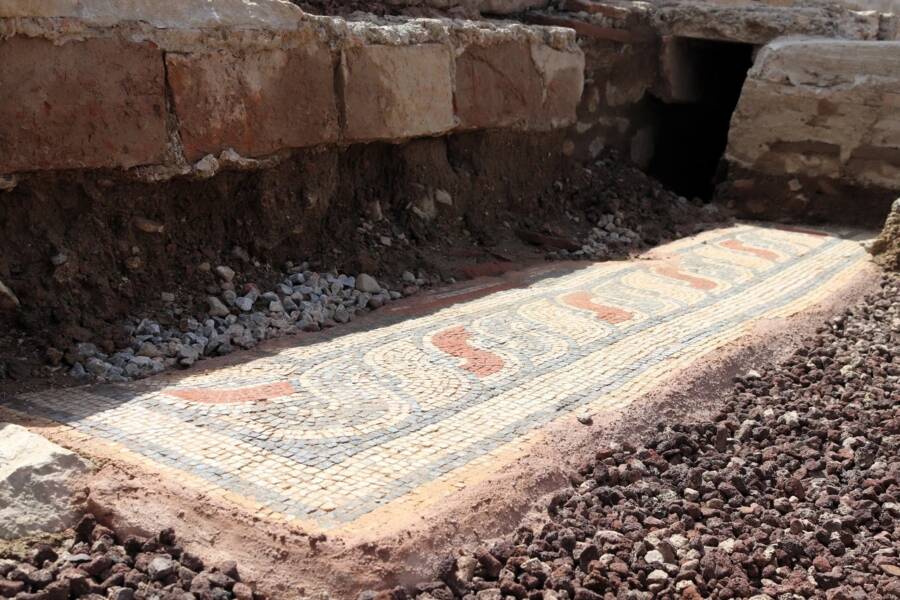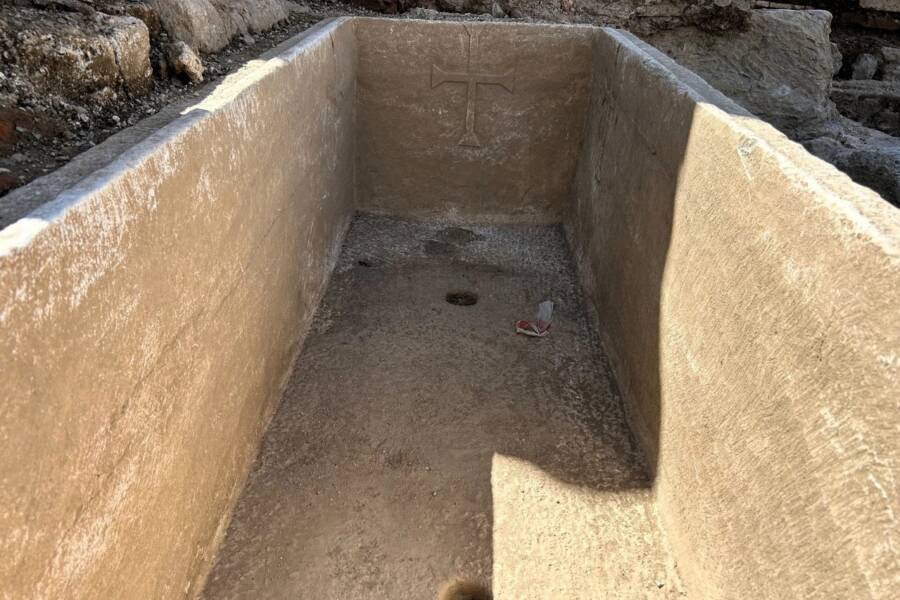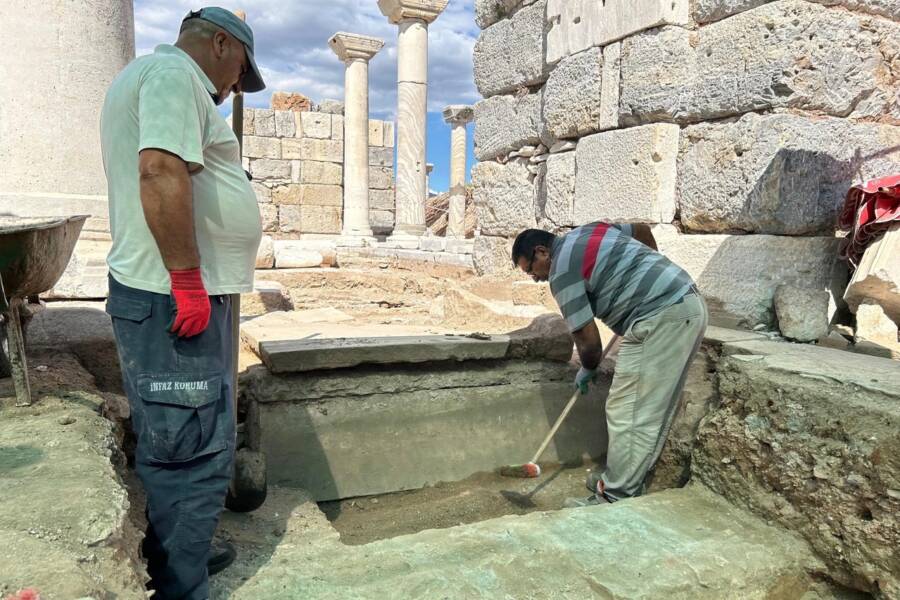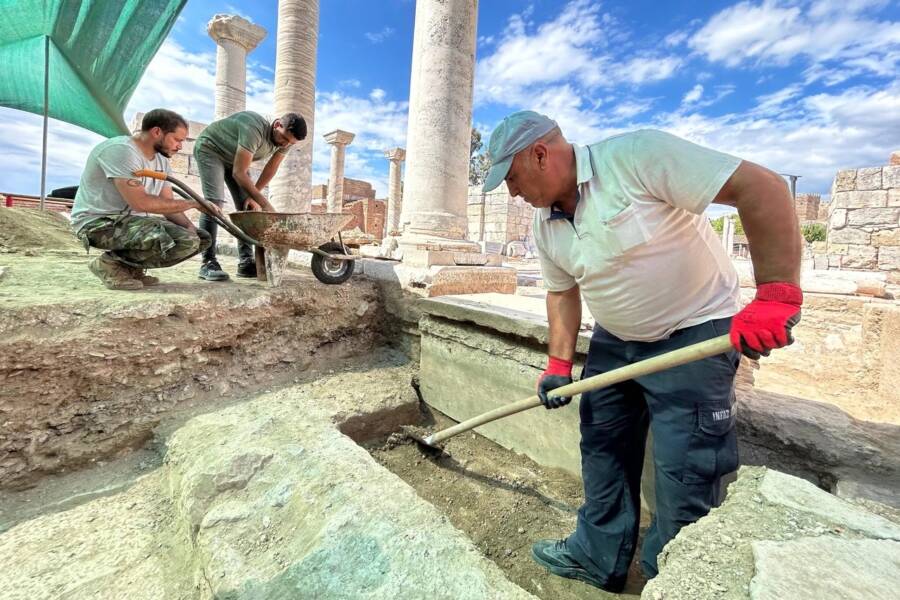While excavating a basilica in the ancient city of Ephesus in western Türkiye, archaeologists unearthed the sarcophagus of a Roman gladiator dating to the third century C.E.

IHA PhotoThe tomb belonged to a gladiator named Euphrates, whose name was inscribed into the sarcophagus.
At Ayasuluk Hill in İzmir, Türkiye, archaeologists recently made a remarkable discovery when they unearthed a tomb belonging to a Roman gladiator from the third century C.E.
Just as remarkable, however, was the revelation that the tomb had been reused during the fifth century C.E., with the remains of 12 other people added to it.
The Sarcophagus Of A Roman Gladiator Unearthed In Türkiye

IHA PhotoThe mosaic floor found beneath the Roman gladiator’s tomb.
The excavation was carried out by Türkiye’s Ministry of Culture and Tourism and led by associate professor Sinan Mimaroğlu of Hatay Mustafa Kemal University. During the dig, Mimaroğlu and colleague Ertan Yıldız not only unearthed the gladiator sarcophagus, they also learned a bit about its original inhabitant.
As Türkiye Today reports, the researchers found an inscription on the outside of the sarcophagus featuring the name “Euphrates,” believed to be that of the gladiator, alongside epigraphic inscriptions and cross reliefs believed to have been added later, in the fifth century C.E.

IHA PhotoA cross motif inscribed on the lid of the sarcophagus roughly two centuries after Euphrates the gladiator was buried.
Euphrates’ sarcophagus is quite similar to other sarcophagi from this same era found in Istanbul, Syria, and Marmara Island, though the shape of the crosses differs. Meanwhile, entire gladiator arenas have been found elsewhere in Türkiye, including one in Mastaura and another in Anavarza.
This newly uncovered gladiator sarcophagus is notably different than others like it, however, due to its reuse some 200 years later, when 12 additional people were buried inside.
Additional Discoveries Made Alongside The Gladiator’s Sarcophagus

IHA PhotoThe interior of Euphrates’ sarcophagus, where another cross inscription was found.
Along with the gladiator’s sarcophagus, researchers also found a water channel, drainage system, mosaics, and several other tombs, all of it a mere eight inches below the surface.
“We found one tomb and three tomb-like structures, with 12 individuals inside. This indicates a collective burial,” Mimaroğlu said. “The sarcophagus is a Roman one with a very beautiful epic inscription. It belonged to a Roman gladiator and was repurposed during the Christian period with three cross reliefs added inside.”
This might seem like a strange desecration of a burial that would have already been hundreds of years old when additional burials were added to it, but Mimaroğlu provided some enlightening context about the surrounding church associated with the burial, which helps to explain the history.

IHA PhotoA closeup of the cross motif found on the sarcophagus.
As he explained, this was likely a small burial structure at first. However, it was later converted on two separate occasions. First, it was converted into a wooden-roofed basilica, and later, during the reign of Emperor Justinian I, it was converted once again into a domed church.
“The burials inside the church likely belong to the upper class or clergy, as it’s unlikely an ordinary person would be buried in such a meticulous manner within a church,” Mimaroğlu said.

IHA PhotoMembers of the archaeological team working to excavate the site.
Based on the team’s initial findings, it’s likely that the cross inscriptions inside the sarcophagus were added in the fifth century C.E., with the crosses on the lid possibly being added a few hundred years later, in the seventh and eighth centuries, after ancient Rome became a Christian empire. Likewise, the mosaic beneath the sarcophagus also shows signs of having been altered during Justinian I’s reign.
Furthermore, Mimaroğlu highlighted the site’s overall significance, noting that there is early evidence indicating that this may be the first location of the ancient city of Ephesus before it was destroyed and rebuilt. This is based on ceramics dating to the second millennium B.C.E., as well as ceramics from the Early, Middle, and Late Bronze Ages.

IHA PhotoPrevious excavations at the site had also revealed a bounty of mosaics and other ancient relics.
Mimaroğlu has led the current phase of excavations at the site since 2020, with a focus this year on the South Cross Arm of the Basilica of St. John. Initial excavations at the church began in 1921. In the 100 years since, discoveries like this have not only provided new insights into ancient burial practices, but also life in ancient Ephesus.
After reading about this Roman gladiator’s tomb found in Türkiye, learn all about Commodus, the Roman emperor who went mad with power. Then, read about Crixus, the right-hand man of gladiator-turned-rebel leader Spartacus.





